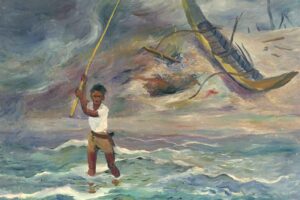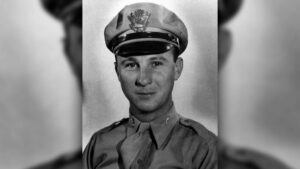Written By: Lt. Col. Edward B. (Buck) Cummings, USMC-Ret.

The defeat of LTC George Armstrong Custer’s famed 7th Cavalry by the Sioux and Northern Cheyenne Indians on 25 June 1876 was the most memorable event of a larger U.S. Army campaign that began in May and concluded in late August of that year. The Army’s 1876 campaign was part of an ambitious plan to secure the Yellowstone River route planned for the Northern Pacific Railway and eliminate the threats from local Indians.
Ultimately, the campaign was a success. After the Little Big Horn battle, the Army gave the Indians no chance to join forces again as they had done so audaciously against Custer. The Yellowstone River and its major tributaries played a significant role in the plans for both sides in this summer campaign.
The Indians and their sustaining buffalo herds closely followed the watercourses of these life-giving rivers. The Army’s use of sturdy mountain steamboats on them allowed it to achieve a sustained military advantage.
The legendary efforts of one of these steamboats in support of the campaign have always been a footnote in the high drama of events surrounding the Custer defeat.
While history will forever debate the character of Custer and his battlefield decisions, it can only award the highest accolades to Captain Grant Marsh and his boat Far West during this epic campaign.

This is the story of that heroic performance. In May 1876, BG Alfred Terry, commander of the Army’s Department of the Dakota Territory, launched a complex campaign westward, from Bismarck into Montana Territory, against the Sioux and Northern Cheyenne Indians.
Planned as a three-pronged effort by separate Army columns to locate and defeat Indian forces opposing the westward progress of the new Northern Pacific Railroad, this campaign’s most memorable event would be its last spectacular failure.
Custer’s defeat at the Little Big Horn River was the last battle of this difficult campaign, which followed closely the repulse of BG George Crook’s column by Crazy Horse at the Rosebud River on 17 June.
The urgent need for water in the dusty high plains of 1876 made it imperative that neither the Army nor its Indian foes stray far from the Yellowstone River or its major tributaries.
A daring captain with a rugged steamboat could make these challenging yet navigable rivers an important factor in the Army’s overall plan for essential logistical support. When Captain Grant Marsh was chosen to provide this support, it began what he would later call “my most memorable journey on the Yellowstone.”
BG Terry rolled out the maps on a large table at Fort Abraham Lincoln, near Bismarck, Dakota Territory, in early April 1876. Poring over the maps with him were COL John Gibbon and LTC Custer. These two officers called each other “general” in deference to the highest rank each had achieved in the Civil War—both had attained the rank of major general before reverting to their permanent ranks after the war.
So it is that history records “General” Custer leading a regiment, normally commanded by a colonel. To him that was a small detail. He was overjoyed, as a lieutenant colonel, to be reinstated as commander of his beloved and hard-hitting 7th Cavalry for what everyone in the Army hoped would be the final campaign against the Northern Plains Indians.
Looking at his maps, Terry reasoned that the rivers would be both a life source and a problem for the Army. He pointed out to his officers the north-flowing tributaries of the Yellowstone River that would impede westward movement once the Army reached the Montana Territory. Terry’s finger traced them all, from the Black Hills in the east to the boundary of the new Yellowstone National Park in the west. First the Powder, then the Tongue, then the Rosebud, and finally the Big Horn, all presented potential river crossing difficulties. The snowmelt runoff of May and June would mean high water and few fording locations for the hundreds of horses, mules, and wagons that would be needed to support the campaign.

A steamboat, ascending the Upper Missouri and Yellowstone Rivers and meeting Terry’s forces at the Powder River, could transport heavy items upriver and eliminate the requirement to ford all of the swift-running rivers unassisted. Terry considered the qualifications and records of the steamboats and captains offered for his use and chose one well-known and respected by his subordinate commanders. They knew they could trust Captain Marsh and the Far West to meet the Army column at the Powder River with supplies and be ready to provide the necessary support.
With the help of this steamboat and its crew, Terry’s army would arrive quickly in the valley of the Rosebud River, where intelligence reports indicated the Indians were gathering in force. In this area buffalo were still found in large numbers, the grass and water would support large herds of Indian ponies, and the lush riverside groves of cottonwood trees would provide fuel and lodge poles for thousands of teepees. The nearest Army forts—Fetterman, Buford, and Ellis—were hundreds of miles away. If there was a place on the high plains where the Indians felt safe, it was in the valleys of the Rosebud and Big Horn Rivers. It was the Army’s intent to enter that perceived sanctuary and permanently remove the Indians from it.
Captain Marsh had made a name for himself with his 1873 and 1875 journeys up the Yellowstone in the steamboats Josephine and Far West. In the Josephine in 1873, he had made an ascent to within sixty miles of the newly established Yellowstone National Park, hundreds of miles further upstream than any steamboat had ever traveled. He did this with the innovative techniques of “sparring” and “warping” his boat up rapids and over sandbars and submerged logs, all in the face of Indian bewilderment if not actual opposition. Due to his ability to lift his boat over obstructions and shallows with spars placed in the river bottom, Marsh had secured his reputation as one of the leading steamboat captains on the Upper Missouri and Yellowstone Rivers.
He also set a number of speed records as well. He was the logical choice to support the 1876 campaign that would secure the Northern Pacific Railway’s planned route and exercise the nation’s “Manifest Destiny” of safe development westward to the Pacific Ocean. Upon learning he would captain the Far West on the Army’s 1876 expedition against the Northern Plains Indians, Marsh proudly displayed the Coulson Packet Company’s elk’s head symbol on the pilot house of the boat. Coulson Packet issued the symbol to the captain of the fastest vessel in the company.
The ambitious Army campaign of 1876 followed other summer campaigns of 1873 and 1874. An 1873 campaign along the Yellowstone River had been launched to protect early surveying parties exploring a route for the Northern Pacific Railroad. Custer had also led the 7th Cavalry during that summer, which included support from the steamboat Josephine, captained by Marsh. During the 1873 campaign, Custer had been delighted to find his old West Point classmate and Civil War Confederate opponent, Tom Rosser, now Chief Engineer for the Northern Pacific. The two spent many hours that summer recounting old times together as cadets or in later battles against each other as young general officers.
The 1874 Black Hills Expedition, as the Army termed its military campaign that year, was an event that ignited Indian resentment. Although a provision of the 1868 treaty dealing with the Black Hills technically allowed the Army to enter that area, the Northern Plains Indian tribes saw the large military movement as a flagrant act of trespassing upon their sacred hunting grounds. Resentment towards that expedition served as a strong unifying force in the tempestuous years that followed. Since his winter victory over Chief Black Kettle on the Washita River in the winter of 1868, Custer had somehow always managed to be in command of the 7th Cavalry Regiment for the biggest campaigns, and he had led the Black Hills Expedition with his usual flamboyant style.
Surviving a general court-martial, temporary expulsion from the Army, and even the disfavor of President Ulysses S. Grant, Custer was still seen as the right man to lead the 7th Cavalry during the 1876 campaign. He could be counted on take the fight to the Indians and stay on the offensive. Logistical considerations drove the planning for these aggressive campaigns as much as the choices of the officers to lead them. Hundreds of grain-fed cavalry horses and mules needed many wagons to transport their nutritional needs. The infantry and cavalry units required a large auxiliary contingent of blacksmiths, hunters, butchers, and bakers.

Overland communications and supply lines stretching back eastward to Fort Lincoln would grow ever longer and more vulnerable as the Army moved westward into Montana Territory. Hiring a steamboat to support the campaign was a wise decision and the Coulson Packet Company, ever ready with its busy fleet of mountain steamboats, answered the Army’s urgent request for support. During the Yellowstone campaign of 1873, Custer had been frustrated by his inability to cross the fast-running Big Horn River. He had been unable to find a fording location and must have reasoned that having a steamboat present to ferry troops and horses would have helped.

This incident alone probably convinced Terry and Custer to plan for support from the steamboats for the 1876 campaign. During the 1876 campaign, the Far West was chartered not only for these movement requirements, but also to serve as Terry’s mobile command post. When the steamboat met the overland advancing column at the Powder River in early June, it became the place where officers met for planning, shared meals, and relaxed in the evening hours.

During this time, Marsh became a friend to most of the campaign’s leading officers, including Custer’s younger brother Tom, an Army captain who twice earned the Medal of Honor during the Civil War, and his youngest brother Boston, who had been hired by the Army to accompany the campaign as a civilian contractor.
Marsh later recalled that “Everyone called the young man ‘Boss.’ When the General (Custer) asked me to keep him onboard Far West and out of the anticipated battle, I tried to do so. One night he left the boat to buy tobacco and never returned, having joined his older brother and the departing column ashore.
I never saw Boston again, as he died with his brothers in the battle on June 25th.” Boston, like his brothers, thirsted for a role in combat and would not have missed the chance to participate in the coming battle. Although Marsh was humble about his part in the overall campaign, his actions were at times both essential and heroic.
On numerous instances he ferried troops, horses, mules, and wagons across rivers, making repeated short runs until the units were completely rejoined on the opposite bank. Terry’s last orders to Custer advised him to meet the Far West at the “juncture of the Horn and Little Horn, if navigation permits” at the expiration of his carried 15-day supply of rations.
This meant that 4 July would have been the last intended date for a rendezvous with the Far West. Captain Marsh must have seen these orders to Custer and surely took the phrase “if navigation permits” as a challenge.
He made the ascent to where the two rivers joined, then tied his steamboat to a large tree in the vicinity of present day Hardin, Montana. This would have been at the absolute upper reaches of navigation for any boat ascending the Big Horn River, and it was less than fifteen miles from the site of the famous “Last Stand” on 25 June.
The exact date of the arrival of the Far West at this location is uncertain, but it was there on the evening of 26 June, when a lookout cried “Indians!” and the crew jumped to their combat stations.

As it turned out, the Indians were chasing a Crow scout named Curley as he hurried to the boat to deliver news of the defeat. Curley had been the last scout released by Custer from participation in imminent combat action.
Curley had witnessed the slaughter from a distance and now struggled to convey the emotional message of it in sign language to the assembled crew of the Far West.
Captain Marsh would later describe the unforgettable scene in a letter: Curley came onboard, crying inconsolably. He traced on the deck two concentric circles. The inner I understood, from the limited Crow language I knew, to be ‘soldiers.’ The outer circle he called ‘Lakota.’ He pointed to the inner circle and punched his chest repeatedly, which we all understood to mean ‘all soldiers dead.’ His message to us was ample evidence that a disaster had taken place.
Within hours of Curley’s dramatic message, several soldiers arrived with the same news. They also brought word that fifty-two wounded soldiers from the battered battalions of CPT Frederick Benteen and MAJ Marcus Reno were on their way to the Far West. BG Terry ordered the transfer of the wounded to take place at night, in cooler conditions and at a time less vulnerable to Indian attack. The wounded were brought to the boat by horse-drawn litters to minimize the jarring of the suffering soldiers. The rapid breakdown of the vast Indian encampment after the battle had left the plain along the Little Big Horn littered with thousands of discarded lodge poles now advantageously used to make the travois to carry the wounded. Marsh directed a main deck mattress to be made and a 12-inch bed of lush green prairie grass was gathered and covered with canvas.
The wounded men were put on this mattress as they arrived, attended by the only doctor available. On 3 July, when the last of the wounded were stabilized and BG Terry had shifted his headquarters ashore, Captain Marsh ordered the Far West underway, bound for Fort Lincoln, 920 miles downstream. He would return the wounded men to the point where the campaign had begun its westward march in May. At several riverside Army forts along the way, Marsh stopped briefly to convey the news. From one of these stops a telegraph operator transmitted the details of the Custer defeat to Fort Lincoln and onward to the War Department in Washington.
The passage of the Far West from the mouth of the Little Big Horn to Fort Lincoln, near Bismarck, was made in fifty-four hours, at an average speed of seventeen knots, with the boat traveling night and day. During this run, which set a record never broken, only two of the wounded soldiers died. The compelling mission to return these soldiers to their home fort and proceed upriver again to support the campaign gave all onboard the Far West new resolve to push the boat and themselves to the limit.
With the sad news conveyed and the wounded safely returned to Fort Lincoln, Captain Marsh expedited the loading of provisions and returned to the mouth of the Bighorn. Three other Coulson Packet Company steamboats, the Josephine, Carroll, and Durfee joined the Far West in supporting campaign beginning in the month of July. Before the end of the campaign, the Josephine and the Far West would each make at least two round trips between Bismarck and BG Terry’s new base camp at the mouth of the Rosebud River. The 910-mile river route to Bismarck was run continuously until mid-August, when the Yellowstone River water level dropped to an extent that made navigation hazardous.
Realizing the difficulties that overland resupply to his exhausted cavalry and infantry units would present, BG Terry ended his campaign in late August. The quick movements of his units, made possible by employment of the steamboats, had kept the Indians on the run throughout the entire summer. Although a general engagement with them did not take place after Custer’s battle, the Indians were never able to rest or adequately prepare for the coming hard winter months. The Army soon concluded, in spite of the defeat on the Little Bighorn in June, that the overall campaign was a success, although the campaign would not officially conclude until September 1877.
The energy and resourcefulness of the steamboat captains, and Captain Grant Marsh in particular, stood out as exemplary factors in a campaign of prolonged logistical difficulties. Following the 1876 campaign, Marsh went on to complete a career captaining twenty-one other steamboats. His beloved Far West hit a snag in the Missouri River and sank on 20 October 1883 near St. Charles, Missouri, resulting in the total loss of the steamboat.
The denuded banks of the western rivers, stripped of bordering cottonwoods for miles by the voracious fuel demands of the steamboats, began to recover in about 1880, when the boats switched from wood to coal to power their boilers. The railroads soon pushed on to the Pacific and made the steamboats obsolete along the western rivers, but the boats had left their mark on the sacred Indian hunting lands as well as earning their place in the historical record of the Army’s high plains campaigns. Grant Marsh lived to age 82 and died in 1916, one of the last surviving principal actors on the grand stage of the Little Bighorn battle drama.





